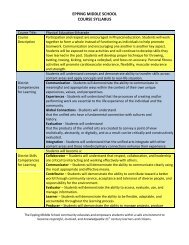Reading Standards for Informational Text & Literature - SAU 14
Reading Standards for Informational Text & Literature - SAU 14
Reading Standards for Informational Text & Literature - SAU 14
You also want an ePaper? Increase the reach of your titles
YUMPU automatically turns print PDFs into web optimized ePapers that Google loves.
Middle School<br />
6th Grade 7th Grade 8th Grade<br />
Key Ideas and<br />
details<br />
Craft and<br />
structure<br />
Use evidence to make<br />
inferences<br />
Summarize text and find<br />
theme and main ideas<br />
Relate plot in sequence<br />
and show how characters<br />
react to change<br />
Define words in context<br />
and show how word<br />
choice affects tone<br />
Show how a section of a<br />
text fits in and how it<br />
helps develop themes,<br />
setting, or plots<br />
Recognize the narrator’s<br />
point of view<br />
Show evidence to support<br />
what the text means<br />
Summarize the text and<br />
trace the development of<br />
the main idea or theme<br />
Show how the elements<br />
of a story work together<br />
Define words in context,<br />
interpret figurative<br />
language, understand<br />
rhyme and theme and the<br />
repeating of sounds, and<br />
show how they affect the<br />
text<br />
Show how a drama’s or<br />
poem’s <strong>for</strong>m helps get<br />
across the meaning<br />
Show how the author<br />
develops the different<br />
points of view of the<br />
characters or narrators<br />
Show evidence about<br />
what the text means and<br />
interpret inferences in<br />
the text<br />
Summarize a text and find<br />
the main idea and how it<br />
is supported by details<br />
Show how dialogue or<br />
incidents in a text affect<br />
the action, tell us about<br />
the character, and help<br />
the characters come to a<br />
decision<br />
Define words from<br />
context including<br />
figurative language, and<br />
point out references to<br />
the text<br />
Compare and contrast<br />
two or more texts and<br />
point out the different<br />
structures of the texts<br />
Show how the different<br />
points of view of the<br />
characters and the<br />
audience or reader create<br />
suspense or humor<br />
Integration of<br />
Knowledge<br />
and Ideas<br />
Compare and contrast<br />
reading a story to viewing<br />
or listening to it<br />
Compare and contrast<br />
different <strong>for</strong>ms of<br />
literature on the same<br />
theme or topics<br />
Compare and contrast a<br />
written piece of literature<br />
to its audio, filmed,<br />
staged, or multimedia<br />
version<br />
Compare and contrast<br />
fictional and historical<br />
pieces written about the<br />
same time, place, or<br />
character<br />
Show how filmed or live<br />
per<strong>for</strong>mances of a story<br />
or drama are similar to<br />
the original text<br />
Show how modern<br />
literature refers to myth,<br />
traditional stories, or<br />
religious works<br />
<strong>Reading</strong> <strong>Standards</strong> – In<strong>for</strong>mational <strong>Text</strong> and <strong>Literature</strong> Epping School District Page <strong>14</strong> of 16
















